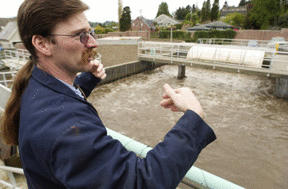From the standpoint of sheer physical capacity, the Bainbridge Island wastewater treatment plant at the foot of Donald Place has a lot of life left in it.
But to comply with ever-tightening regulations, changes are needed. The city has hired a consulting engineer to look at the operation with an eye to upgrades, and wants to get neighborhood input right from the start.
“We want to make sure the neighborhood is aware of the efforts that are under way, and to get their input into the process before it becomes final,” said Lance Newkirk, city maintenance and operations supervisor.
“We expect feedback concerning odor, noise, lighting and perhaps even traffic,” Newkirk said. “The input we get from the neighborhood may help in siting new equipment, for example.”
City staff and Bainbridge sewer consultant Rick Esvelt will discuss the plan at a neighborhood meeting, 5-7 p.m. May 15 in the council chambers at city hall.
Possible upgrades are being driven by diverse factors – new effluent standards coming from the State Department of Ecology, future work that will close the Hood Canal Bridge for a period of time, and some cost-saving opportunities.
The new effluent standards don’t deal directly with the quality of discharged water, already clean enough to support several healthy fish that swim in undiluted water in an aquarium in the plant’s small laboratory.
Rather, the standards relate to the amount of residual chlorine leaving the plant via the Eagle Harbor outfall.
“We use liquid chlorine, which is pretty much like household bleach but double the strength,” said plant supervisor Steve Pyke. “Before 1995, we used chlorine gas, but with the area around being built up, we changed to liquid.”
Options are to go to an ultraviolet process or to add another chemical to take out the chlorine, Newkirk said.
Disposal of “bio-solids” – the plant byproduct, formerly known as “sludge” – is complicated by the scheduled 2006 closure and partial replacement of the Hood Canal Bridge.
Actually about 98 percent water, the biosolid material is trucked to several commercial tree farms in Jefferson County, where it is sprayed on the soil.
While the material seems to boost tree growth, Pyke says, there are stringent and time-consuming regulatory requirements involved in permitting such sites.
If another site can’t be located – and Newkirk has no illusions that it would be possible to find such a site on Bainbridge – the alternative is to add a heat-treating process that would kill all the germs, which would make the material marketable and usable as a soil amendment.
Esvelt is also looking at the condition of the equipment, some of which dates back to the 1978 opening of the plant.
“The plant is the most energy-intensive operation in the city,” Newkirk said. “We are looking for ways to cut down on energy use.
“We’re also looking for more processes that we can operate remotely, because we can monitor the treatment processes more closely.”
New regulations are requiring greater redundancy, Newkirk said, and changes will be required to meet those rules.
“Essentially, you have to have two of everything,” he said, “so that if something goes down, you remain in compliance.”
Liquids, solids
For all the talk of machinery, the sewage treatment process itself is not mechanical but biological.
Effluent from the city’s sewer connections flows into the plant, passes through screens to remove non-biological contaminants, then goes into an “oxidation ditch.” There, rotors keep the water moving and expose it to air, and bacteria begin breaking down the solid materials.
After 10 days of oxidation, the water goes into another trough where it sits for 40 to 50 days while bacteria further digest the solids.
The third step is a clarifier, a settling and separation basin where the remaining solids settle to the bottom and clear liquid floats to the top.
The materials then move to their last stage. Solids go to a thickener, where, after further settling and compression, they are pumped from the bottom into the disposal trucks.
The liquid goes into a contact chamber where chlorine is introduced to kill remaining bacteria. After one to two hours there, the liquid is pumped into pipes that run along the beach on the north shore of Eagle Harbor and through a tunnel under Wing Point to the point of discharge into Puget Sound.
Operating the plant is a blend of science and art.
“It’s a living process dealing with biology, and each day it is different depending on temperatures, rainfall and so on,” Newkirk said. “We feel that this facility is very well run.”
When the plant was last upgraded in 1994, several improvements were made to make the facility a better neighbor to surrounding residents.
The plant was walled off, and netting was added to keep inquisitive birds at bay; officials hope the upcoming public meeting will gauge the success of those efforts.
Assuming that the plant can be modified to stay abreast of regulatory changes, officials say it has substantial useful life left. The design capacity is 1.2 million gallons per day, and the plant currently operates at less than 50 percent capacity, with an average of 500,000 gallons per day.
System use has increased from 900 connections in 1991 to 1,534 today in a service area that includes the Winslow core, running west to Finch Road and north to New Brooklyn, with an irregular boundary on the east. Usage cannot readily be correlated with population growth, because multi-family developments generally have only one hookup.
Longevity can be increased by repairing aging pipes, which allow fugitive water to infiltrate into the system.
“When we have an inch of more of rain, the amount of water we have to treat increases noticeably,” Newkirk said.
At some point, though, a significant expansion will be needed.
“When you reach 85 percent of design capacity, the Department of Ecology requires you to have designs prepared for expansion,” Newkirk said.
“And that will be a very major undertaking.”



